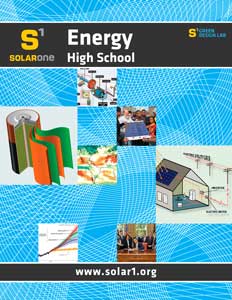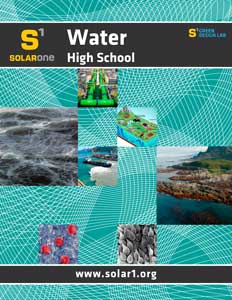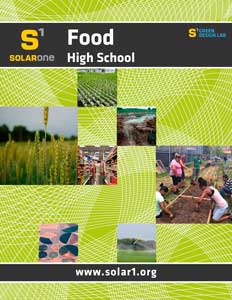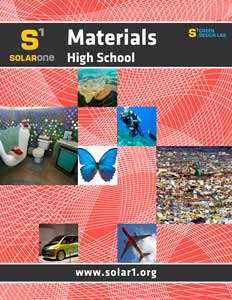High School Curriculum
Energy

Table of Contents and Introduction
Acknowledgements, Table of Contents, Module Overviews and Curriculum Map
Module 1: Intro to Energy
Introduces the basics of energy as a physical concept and the laws that govern it. The focus then shifts to energy sources, with an in-depth look at the origin, production and use of fossil fuels. Using maps and independent research, students will develop energy profiles of specific countries and develop a strategic energy plan for each.
- Lesson 1: What is Energy? How Do We Use It?
- Lesson 2: Sources of Energy and Self-Sufficiency
Module 2: Electricity Production and the Grid
A study of modern electricity production and distribution. Lessons encompass the history and mechanics of electricity as well as emerging smart grid technology and policy. Activities range from constructing simple circuits and generators to conducting cost-benefit analyses of power plants.
- Lesson 1: Electricity Production: The Power Plant
- Lesson 2: Moving Electricity: Circuitry
- Lesson 3: Electricity Distribution and the Grid
Module 3: Climate Change
Explores the relationship between our energy use and the Earth’s changing climate as well as the projected social, environmental and economic impacts. The Module also explores responses to climate change on a global, national and local level. Students will use Paleolithic ice core data to analyze historic CO₂ levels and will develop maps to identify global climate trends.
- Lesson 1: An Introduction to the Climate System
- Lesson 2: Emissions, Indicators, and Effects
- Lesson 3: Responding to Climate Change
Module 4: Building Science
Focuses on energy use in buildings. Students will employ concepts and techniques of Building Performance to evaluate the air flow and electricity use of their classroom and school building, identifying areas needing improvements and avenues of remediation. In this hands-on oriented module, students learn to use several “tools of the trade” including a watt-meter and infrared thermometer. Students will conduct a building audit of the school and generate a full report with recommendations.
- Lesson 1: Building Science: Why Does it Matter
- Lesson 2: Building Science: Lighting and Appliances
- Lesson 3: Heating and Cooling
- Lesson 4: Building Occupants: People and Energy Consumption
- Lesson 5: Conducting a School Building Energy Audit
Module 5: Renewable Energy
Introduces students to the mechanics and applications of various forms of renewable energy. Students will investigate the benefits, challenges, science and emerging technologies of each as well as renewable energy policy and career pathways in this dynamic sector. Several engaging activities include creating biofuel, building solar thermal water heaters and constructing batteries.
- Lesson 1: Introduction to Renewable Energy
- Lesson 2: Photovoltaics and Solar Thermal
- Lesson 3: Wind Power
- Lesson 4: Biomass
Module 6: Wrap Up
Brings together all of the topics students have explored throughout the CleanTech Energy Unit. CleanTech wrap up activities build on design, engineering, policy and economic skills students learned throughout the Unit, encouraging students to apply what they have learned to a final project. These activities can be done as independent team projects or as extended classroom lessons.
Water

Table of Contents and Introduction
Acknowledgements, Table of Contents, Module Overviews and Curriculum Map
Lesson 1: Water Availability
In this lesson students will investigate factors and trends in water availability as well as issues of water scarcity and possible avenues of mitigation.
Lesson 2: Water Quality
In this lesson, students explore watershed health and factors affecting drinking water quality.
Lesson 3: Bottled Water vs. Tap Water
In this lesson, students investigate the difference between bottled and tap water and the associated impacts of each.
Lesson 4: Aquatic Ecosystems
In this lesson students survey the basic types of aquatic ecosystems and their importance to both biological and human communities. Students will also understand the natural and human factors threatening aquatic ecosystems and how to use biological indicators to assess the health of a waterbody.
Lesson 5: Water and Climate Change
In this lesson, students examine the impacts of climate change on water resources and the human activities and ecosystems that depend on them.
Lesson 6: Water Conservation
In this lesson, students investigate methods and impacts of water use and conservation.
Lesson 7: Wastewater Treatment
In this lesson, students are introduced to characteristics and examples of sustainable materials. In addition, students will closely examine the life cycle assessment, a tool used to evaluate the environmental impacts of materials.
Lesson 8: Stormwater Management
In this lesson, students are introduced to issues of stormwater runoff and management. They will investigate various technologies and methods of designing and sizing green infrastructure.
Glossary
The glossary applies to all lessons within the Water curriculum.
Food

Table of Contents and Introduction
Table of Contents and Introduction: Acknowledgements, Table of Contents, Module Overviews and Curriculum Map
Lesson 1: Food Systems
In this lesson, students are introduced to the cycle of food production and consumption and think critically about the impacts of this system.
Lesson 2: Industrial Agriculture
The Business of Food: In this lesson students will investigate the history and characteristics of industrial agriculture and the associated impacts on the environment and human health.
Lesson 3: Processed Food, Health and Nutrition
In this lesson students explore processed food and its impacts on health and nutrition.
Lesson 4: The Science of Soil
In this lesson, students will investigate properties of soil and indicators of soil quality. In addition, students will understand approaches to soil quality management and enhancing soil through sustainable agricultural practices.
Lesson 5: Population and Food Production
In this lesson, students will explore the relationships and implications of human population growth, carrying capacity and food production.
Lesson 6: Towards a New Food System
In this lesson, students are introduced to a variety of innovations and alternatives to production and consumption in the industrial food system.
Lesson 7: Food Production for an Urbanizing World
In this lesson, students are introduced to emerging methods and approaches to sustainable food production.
Glossary
The glossary applies to all lessons within the Food curriculum.
Materials

Table of Contents and Introduction
Acknowledgements, Table of Contents, Module Overviews and Curriculum Map
Lesson 1: Intro to Materials
This lesson is a brief introduction to materials and materials science. In a set of hands-on investigations and research, students will classify various materials and evaluate their properties.
Lesson 2: Life Cycle of Materials
In this lesson, students examine the life cycle of materials and the associated environmental impacts of each phase of the process.
Lesson 3: Waste And Recycling
In this lesson students are introduced to waste streams and methods of waste management and recycling. The health and environmental impacts of waste disposal are also explored.
Lesson 4: Production-Consumption Cycle and the Consumer
In this lesson, students examine the impacts of the consumer on the production-consumption cycle and investigate new approaches to consumption patterns.
Lesson 5: Electronics and E-waste
In this lesson, students investigate the issues and processes of manufacturing and disposing of or recycling electronic goods and equipment.
Lesson 6: Material Focus Concrete
Concrete: In this lesson students are introduced to the environmental impacts of concrete as well as developments in the field towards creating a more sustainable building material.
Lesson 7: Sustainable Materials
In this lesson, students are introduced to characteristics and examples of sustainable materials. In addition, students will closely examine the life cycle assessment, a tool used to evaluate the environmental impacts of materials.
Lesson 8: Green Architecture
In this lesson students explore the principles and materials of sustainable architecture and green construction as well as the role they play in climate change. In addition, students are introduced to the evaluation tools of green buildings and examples of sustainable architecture at work.
Lesson 9: Biomimicry
In this lesson, students investigate the interdisciplinary field of biomimicry, including examples of real-world application, biomemetic design processes and challenges to widespread implementation.
Glossary
The glossary applies to all lessons within the Materials curriculum.
